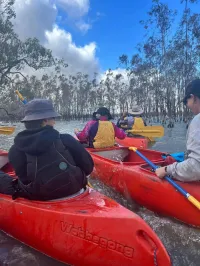0488 770 370
blog
Welcome to the Wildside Blog!
Embark on an adventure of discovery with the Wildside Outdoors blog. Here, we dive into everything from outdoor education to the thrilling experiences that define adventure in the Sunraysia region and beyond.
blog
Get Ready, Get Set, Get Outdoors!
Discover a world of adventure in Mildura and Sunraysia. Let us guide you to new experiences, essential tips, and all the tools you need to connect with nature. Don't miss out—check out our latest articles below!
latest blog posts

Canoe vs Kayak: What’s the Difference?
When it comes to getting out on the water, two popular options are canoeing and kayaking. Whether you’re looking for a relaxing paddle down a river or something a bit more adventurous, both canoes and kayaks offer plenty of fun. But what’s the difference between a canoe and a kayak? Let’s dive into the details and help you decide which one suits your style.
What's the Difference Between a Canoe and Kayak?
At first glance, both canoes and kayaks are small watercraft that use paddles, but the design and usage differ quite a bit. A canoe typically has an open-top design, with the paddler either sitting or kneeling inside, using a single-bladed paddle to propel forward. On the other hand, a kayak usually has a closed deck, with the paddler seated with legs extended, using a double-bladed paddle.
Types of Paddling Activities
There are many types of paddling activities you can enjoy with both canoes and kayaks. Here are a few popular ones:
Flatwater Recreation: The most common type, where you leisurely paddle across calm lakes or slow-moving rivers. This is perfect for beginners looking to get a feel for paddling.
Sea Kayaking: More adventurous, this involves kayaking on the open ocean. The Australian coastline is particularly popular for this type of paddling.
Whitewater Kayaking: This is for thrill-seekers navigating rapids, and it requires both skill and specialized equipment. Check out more on whitewater kayaking at American Whitewater.
Canoe Polo: A competitive team sport that combines canoeing with elements of water polo. To learn more about this unique sport, visit the International Canoe Federation here.
Marathon Racing: Long-distance paddling, typically in canoes, over long river courses like the Murray River.
Health Benefits of Canoeing and Kayaking
Paddling is not just fun—it’s great for your health! Both activities are low-impact, which means they don’t put too much strain on your joints. Some benefits include:
Improved cardiovascular fitness
Increased muscle strength, particularly in the back, arms, and shoulders
Enhanced torso and leg strength, as paddling uses your entire body
Learn more about the benefits at Better Health Channel here.
Other Benefits of Canoeing and Kayaking
Besides the physical benefits, paddling is a peaceful way to connect with nature. It can be meditative as you glide through calm waters, or exhilarating when you tackle challenging waves. It’s also a fantastic way to explore hidden waterways and get up close to wildlife.
Preparing for Canoeing and Kayaking
Before you hit the water, it’s important to prepare. Start by joining a local paddling club to learn the basics of paddling. Make sure you’re comfortable in the water by brushing up on your swimming skills. And always “try before you buy” by renting equipment to see if you enjoy the activity before investing in your own gear. For tips on finding a club, you can check out Paddle Australia here.
Basic Kit for Canoeing and Kayaking
Your kit may vary depending on the type of paddling you plan to do, but here are some essentials:
Canoe or kayak
Paddle (single-bladed for canoes, double-bladed for kayaks)
Personal flotation device (PFD)
Helmet (for whitewater or sea kayaking)
Wetsuit and booties (for colder conditions)
For a complete beginner’s kit guide, refer to Kayak Academy here.
What to Take When Canoeing and Kayaking
In addition to your basic kit, it’s wise to bring the following:
First aid kit
Drinking water and energy snacks
Dry clothes in a waterproof bag
Mobile phone in a waterproof case
Sea Kayaking – Extra Equipment
If you’re planning on heading out to sea, you’ll need additional safety gear, including:
Bilge pump and bailing device
Distress signal devices like flares or smoke sticks
Compass and marine radio
Spare paddle
Health and Safety Suggestions for Canoeing and Kayaking
Safety is crucial on the water. Here are some tips to keep in mind:
Always wear your PFD and helmet.
Check the weather and water conditions before setting out.
Don’t paddle alone and always let someone know your plans.
Stay visible to other watercraft with reflective gear.
Avoid dehydration by bringing plenty of water.
For a complete guide on paddling safety, visit Paddling.com here.
Canoe vs Kayak: What’s the Difference?
Now, let’s break down the key differences between canoes and kayaks:
Design: Canoes have an open top with higher sides to prevent water from splashing in, while kayaks are more enclosed and lower to the water. Canoes tend to be larger with more storage, while kayaks are smaller and lighter.
Paddling Techniques: Canoe paddlers use a single-bladed paddle and alternate sides to move forward, while kayakers use a double-bladed paddle, dipping one side then the other.
Stability vs. Speed: Canoes are generally more stable and harder to capsize, making them ideal for beginners and longer trips. Kayaks, however, are faster and more nimble, perfect for navigating tight spaces or rough waters.
Is it Easier to Kayak or Canoe?
Both canoes and kayaks have their advantages. Canoes are more stable and easier for beginners to get comfortable with. However, kayaks are more nimble and faster, making them a bit more thrilling for those who want to pick up the pace. Your choice depends on your preferences for stability vs. speed.
Where to Go Canoeing and Kayaking
You can paddle just about anywhere there’s water. Lakes, rivers, and oceans are the usual go-tos. If you’re a beginner, start on a calm lake or slow-moving river. Mildura's iconic Murray River is a fantastic spot for both novices and seasoned paddlers, offering tranquil sections ideal for beginners and scenic, flowing stretches for those seeking a bit more adventure. For equipment and advice on exploring the Murray, check out Wildside Outdoors’ hire options here.
FAQ’s About the Difference Between a Canoe and Kayak
Q: Which is easier to learn, canoeing or kayaking?
A: Canoeing is often considered easier for beginners because of the boat’s stability. However, kayaks are more maneuverable and quicker to paddle.
Q: Can you use a kayak in the ocean?
A: Yes, kayaks are great for sea paddling because they’re more enclosed and designed to handle waves better than canoes.
Q: Do I need a spray deck for kayaking?
A: It’s recommended if you’re paddling in rough waters to prevent water from entering the kayak.
Q: Can I paddle a canoe or kayak solo?
A: Yes, both can be paddled solo, but canoes are generally larger and designed for two people, so it may be a bit trickier.

FOLLOW US
ADVENTURE ACTIVITIES
CUSTOMER CARE
LEGAL
Copyright 2025. Wildside Outdoors. All Rights Reserved.


